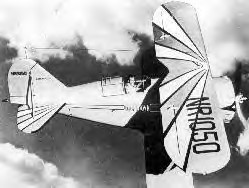One of the most exciting aerobatic aircraft of the 1930s and 1940s was the Grumman Gulfhawk II, built by Grumman Aircraft Engineering Corporation in Bethpage, Long Island, for the Gulf Oil Companies. It was delivered to Roosevelt Field, Long Island, in December 1936 for Major Alfred "Al" Williams, former naval aviator and Marine, who at the time was head of Gulf's aviation department.
This sturdy civilian biplane, powered by a Wright Cyclone R-1820-GI 1,000 hp engine and a three-blade Hamilton Standard propeller, nearly matched the F3F standard Navy fighter that was operational at that time. The wings, of unequal span and, like those of the earlier F2F-1, were constructed of aluminum spars and ribs and were fabric-covered. The fuselage was of monocoque construction, covered with a 0.032-inch aluminum alloy, and could accommodate only the pilot. Modifications were made in the construction to withstand the high-load factors encountered during aerobatics and the aircraft was equipped for inverted flying for periods of up to half an hour.
The Gulfhawk II took its paint scheme from the Curtiss Hawk 1A Gulfhawk, Al Williams' first civilian aerobatic plane. Gulfhawk II's fuselage was painted bright orange with blue trim and the wings had black-edged white stripes radiating rearward and outward on the top surface of the upper wing and the bottom surface of the lower wing.
The airplane thrilled many an air show spectator throughout the United States and Europe from 1936 to 1948. It was a feature attraction at such meets as the Cleveland Air Races, the Miami All-America Air Show, and the New York World's Fair, demonstrating precision aerobatics and the new technique of dive bombing.
In 1938, Williams flew the Gulfhawk II in Europe where aviation enthusiasts in England, France, Holland, and Germany were treated to his daring maneuvers in the colorful little biplane. During this overseas visit the only other person ever to fly the Gulfhawk II, the famous German World War I ace Ernst Udet, piloted the aircraft over Germany. In exchange, Major Williams became the first American to fly the vaunted Messerschmitt 109.
The Gulfhawk II also became a flying laboratory. A new pilot's throat microphone was tried out in it in 1937 and during Word War II it was used to test oils, fuels, and lubricants under extreme operating conditions. In 1942, at the request of General H.H. Arnold, Williams made a three-month tour of fighter schools and training bases to demonstrate airmanship and precision aerobatic flying to pilot trainees.
On October 11, 1948, the Gulfhawk II, NR1050, made its last flight before its donation by the Gulf Oil Corporation to the National Air and Space Museum. At Washington National Airport, Major Williams took his airplane through a demonstration of aerobatics, and then taxied to a strip adjacent to the airport administration building where he shut off the engine and removed the control stick, thus formally decommissioning the historic airplane. The aircraft was displayed for a time in the Arts and Industries building and, from 1976 to 1998, in the Museum's West End gallery.
 Manufacturer: Grumman
Manufacturer: Grumman
Upper wingspan: 28 ft. 7 in. (8.72 m)
Lower wingspan: 26 ft. 1 in. (8.18 m)
Length: 23 ft. (7.01 m)
Height: 10 ft. (3.05 m)
Weight: 3,583 lb. (1,625 kg)
